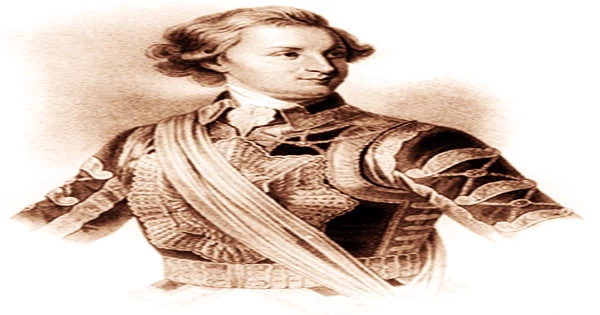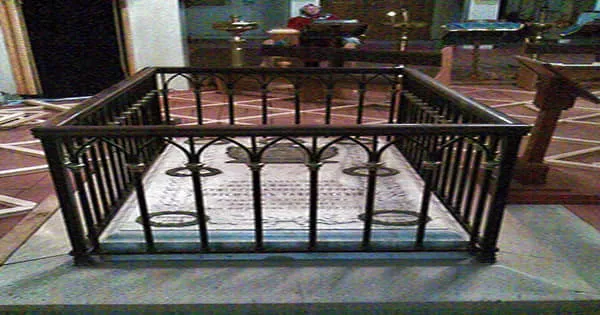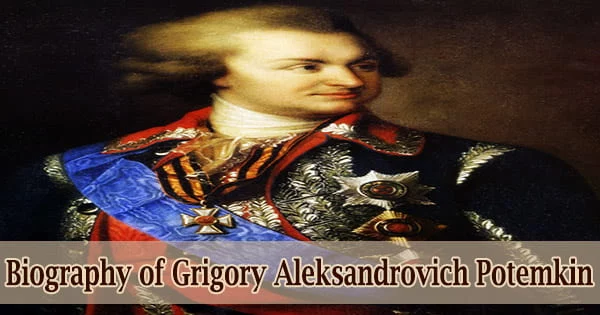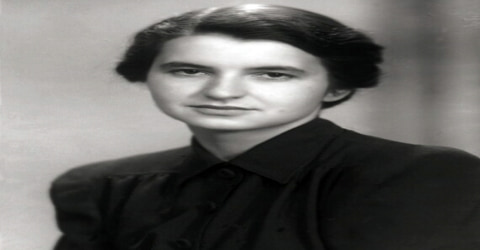Full name: Prince Grigory Aleksandrovich Potemkin-Tauricheski
Date of birth: 11 October 1739 (N.S.)
Place of birth: Chizhovo, Russian Empire
Date of death: 16 October 1791 (aged 52) (N.S.)
Place of death: Jassy, Principality of Moldavia
Occupation: Military leader, Statesman
Father: Alexander Potemkin
Mother: Daria Skuratowa
Spouse / Domestic partner: Catherine II of Russia (possible)
Children: Yelizaveta Grigoryevna Tyomkina
Early Life
Prince Grigory Aleksandrovich Potemkin-Tauricheski (/pəˈtɛmkɪn/, also UK: /pɒˈ-/, US: /poʊˈ-, pəˈtjɔːm-/; Russian: Князь Григо́рий Алекса́ндрович Потёмкин-Таври́ческий, tr. Knjaz’ Grigórij Aleksándrovich Potjómkin-Tavrícheskij, IPA: ɡrʲɪˈɡorʲɪj ɐlʲɪkˈsandrəvʲɪtɕ pɐˈtʲɵmkʲɪn tɐˈvrʲitɕɪskʲɪj), sometimes known as Grigory Potemkin, was a Russian statesman, military commander, and aristocrat best remembered for being Catherine the Great’s lover. He was the subject of numerous anecdotes and was a capable administrator who was licentious, extravagant, devoted, kind, and magnanimous. He passed away as the Treaty of Jassy, which put an end to the war he had presided over with the Ottoman Empire, was being negotiated.
As was the case with the majority of children born into noble families, his future was already predetermined because he was born and bred in a noble Russian family and had to serve the Russian state. He did well in school and developed into a knowledgeable young man. He eventually became Catherine’s favorite, consort, and lover. He remained her lifetime friend and preferred statesmen after their romance faded. A Grand Admiral and the commander of all of Russia’s land and irregular forces, Catherine gained for him the title of Prince of the Holy Roman Empire and bestowed upon him the title of Prince of the Russian Empire among many others.
Potemkin enrolled in the Moscow University before joining the Horse Guards in 1755. He received a modest estate for his assistance in establishing Catherine as the empress. He excelled in the 1768–1774 Russo–Turkish War, and in 1774 he started dating Catherine. He was appointed governor-general and commander-in-chief of “New Russia” (southern Ukraine), stayed cordial with her, and his power persisted despite Catherine having additional partners.
Malaria-related complications caused his death in 1791. His administration in the south is associated with the creation of painted facades meant to resemble real communities filled with contented, well-fed residents for the viewing pleasure of visiting authorities, known as the “Potemkin village,” which is probably a hoax. Potemkin had a reputation for enjoying ladies, gambling, and material success. The Tauride Palace in St. Petersburg was one of the numerous historically noteworthy structures he oversaw during construction.
Childhood and Educational Life
A middle class landowner family from the village of Chizhovo, close to Smolensk, Daria and Alexander Potemkin were the parents of Grigory Aleksandrovich Potemkin-Tauricheski, who was born on October 11, 1739. His mother Daria Vasilievna Kondyreva (1704–1780) was “good-looking, capable, and intelligent,” however their marriage finally failed. His father, Alexander Potemkin, was a decorated military hero. Potemkin was given his first name in honor of the civil servant who served as his godfather and was a relative of his father’s, Grigory Matveevich Kizlovsky.
However, there were rumors that Grigory’s parents were not a happy couple. It was also believed that Grigory was named after his father’s cousin Alexander and that his biological father was Alexander. Grigory’s godfather was also his uncle, Grigory. After his father passed away, Grigory Potemkin’s mother Daria assumed responsibility for raising her family.
It was anticipated that Grigory, who was born into a wealthy Russian family, would one day serve the Russian aristocracy. He was raised with the idea that he would serve the Russian Empire because he was the son of a noble family, albeit a small one. He needed to get the highest caliber of education in order for it to occur. After the family relocated to Moscow, Grigory attended a gymnasium school that was a component of the University of Moscow for his education. Grigory learnt languages and followed the customs of the noble families, focusing mostly on the Russian Orthodox Church. At the age of 11, he joined the Russian army.
Educated at the University of Moscow, Potemkin entered the Horse Guards in 1755. Grigory Potemkin excelled in his studies and won the university’s gold medal in 1757. He then joined the twelve-person group that was dispatched to Saint Petersburg. He had also enlisted in the Horse Guards Regiment when he was a teenager.
Potemkin appears to have been influenced by the trip because he didn’t study much after that and was quickly expelled. In order to avoid being separated from his family, he reenlisted in the Guards, where he excelled. His net value at this time was 430 souls (serfs), which was comparable to that of the lower gentry. He became heavily indebted as a result of his time being consumed by “drinking, gambling, and promiscuous lovemaking.” When nothing else appeared to be working, he further relocated to St. Petersburg and joined the Horse Guards Regiment.
Personal Life
Grigory Potemkin, who is known for being his lover and whose life was dedicated to serving his country and his Empress Catherine II, never married. He lacked a natural successor, but rumors suggested that he had a large number of illegitimate children from his numerous affairs. Although 1775, 1784, and 1791 have all been proposed as potential wedding dates, Catherine first specifically referred to Potemkin as her spouse in correspondence in December 1784.

In total, 22 letters from Catherine hinted that he had at least discreetly taken on the role of her consort. According to reports, Grigory was a haughty but good-hearted man who projected a certain charm and was well-liked by women. The relationship between Catherine and Potemkin persisted despite the fact that it appeared to be over, and it continued to rule their lives. This typically resulted in a love triangle in the court involving the two and Catherine’s most recent swain.
Potemkin was obnoxious, demanding of his courtiers, and prone to mood swings, yet he was also interesting, kind, and welcoming; he “exuded both danger and welcome.” He was “amply endowed with’sex appeal,’” according to the consensus of his female friends.
Working and Political Career
Emperor Peter III was deposed in June 1762 as a result of a coup against the Russian monarchy, and Catherine II was installed as the new monarch. As a participant in the coup, Grigory soon won the new Empress of Russia over with his charm and humor. He received a promotion to second lieutenant. Although Grigory was one of Peter III’s guards when he was found dead in July, he was proven to be entirely innocent. Grigory Potemkin was chosen by the Empress to serve as a Kammerjunker, or gentlemen of the bedchamber, in addition to serving in the guards.

Due to Grigory’s amusing impersonations of well-known people, including the Empress herself, the Empress somehow developed a personal attachment to him as well. The Empress also gave him access to her inner circle of close friends and lavishly bestowed upon him properties and money. Grigory made the most of the Empress’s generosity to amass a large wealth for himself. Many courtiers were shocked that Catherine did not object to the blatant flirtation he displayed with the Empress.
In 1762, Grigory Potemkin was assigned to a diplomatic mission in Sweden. Upon his return, he was involved in an accident that resulted in the loss of one of his eyes. He experienced a severe depressive episode, gave up all of his court posts, and started leading a hermit’s life. But the Empress had grown emotionally attached to him at that point and had mandated that he show up in court 18 months later. He was appointed the army’s paymaster and the head of uniform manufacturing.
The issue of Russia’s southern borders and the future of the Turkish empire piqued Potemkin’s intense interest. However, Grigory Potemkin was a highly effective statesman who carried out his duties with diligence. He did not misuse his position. Thus, he gained the Empress’s continued faith and soon found himself in charge of crucial royal subjects. As a result, he rose to become one of the most influential people in the Russian Empire.
He drew out the blueprint for the conquest of the Crimea in 1776, which was later carried out. The so-called Greek project, which attempted to revive the Byzantine Empire under one of Catherine’s grandchildren, kept him very busy as well. He had spies who were well-informed in various Balkan countries. Although his relationship with the Empress was short-lived and ended in 1776, Catherine continued to put her trust in Grigory in regards to crucial court concerns. He continued to play a significant role in the Russian court as a result, and he assisted the Empress in diplomatic, general, and administrative problems.
He was then appointed military commander of all of Russia, including the territory of New Russia. He was given the important responsibility of militarizing the southern states and bolstering their economies, and to accomplish this, he launched a number of initiatives that drew traders and settlers from all over Russia and abroad. He was elevated to the rank of field marshal and given the title of prince of Taurida as a result of his sterling service to the country. In the years following his promotion to field marshal in 1784, he overhauled the army and developed a Black Sea fleet that was useful during Catherine’s second Russo-Turkish War (1787-91).
His talent is memorialized in the 1778-started Kherson arsenal, the 1784-built Sevastopol harbor, and the new fleet of 15 lineships and 25 lesser ships. But all of his endeavors were exaggerated. Although biographer Virginia Rounding has some reservations, Simon Sebag Montefiore calls the marriage of Catherine and Potemkin “almost certain.” Although 1775, 1784, and 1791 have all been proposed as potential wedding dates, Catherine first specifically referred to Potemkin as her spouse in correspondence in December 1784.
In his endeavor to carry out a massive plan for the colonization of the Ukrainian steppe, Potemkin spared neither soldiers nor money nor himself. However, he never assessed the cost, and the majority of the plan had to be abandoned when it was only halfway complete. Nevertheless, Potemkin triumphed during Catherine’s tour of the south in 1787 because he covered up all the administrative failings; this is why there is an urban legend that he built fake villages for the empress to pass by. Nikolayev, which Potemkin established in 1789 and is now more popularly known as Mykolaiv, was the second-most prosperous city under his control. Potemkin also initiated the redesign of Odessa after its capture from the Turks; it was to turn out to be his greatest city planning triumph.

For its day, Potemkin’s Black Sea Fleet was a huge endeavor. The British embassy reported that there were 27 ships of the line by 1787. Although far behind the Royal Navy, it put Russia on an equal naval footing with Spain. The creator of New Russia was acting as commander in chief when the second Turkish War started. But the army lacked both readiness and proper equipment. Without the empress’ constant support, Potemkin would have quit during a depressive episode. A.V. Suvorov didn’t regain his courage to besiege and seize Ochakov and Bendery until after he had bravely defended Kinburn.
Many victories were achieved against the Turks during the summer and fall of 1789, notably the Battle of Focşani in July, the Battle of Rymnik and the conquest of Kaushany and Hadjibey (modern-day Odessa), and eventually the Turkish citadel at Akkerman’s surrender in late September. In November, the enormous fortress at Bender capitulated without a struggle. He oversaw the Dniester River military operations in 1790 and held his court in Iaşi with more than just Asian grandeur.
When he returned to St. Petersburg in 1791, he and his companion Alexander Bezborodko made fruitless attempts to depose Platon Zubov, Catherine’s most recent and last favorite. As the chief Russian plenipotentiary, he was required to manage the peace talks in Iași in 1791 when the empress grew impatient. Potemkin was ultimately given the necessary power to negotiate with the Turks (and later to pursue his Polish ambitions) and was then sent back to the south by Catherine. She sent a note after him, reading “Goodbye my friend, I kiss you.”
Death and Legacy
Because Grigory Potemkin also experienced manic depressive spells, bipolar illness was likely the cause of his symptoms. 60 kilometers from Jassy, on October 16 (O.S. October 5), 1791, Potemkin passed away on the open steppe. Incorporating a popular story, historians like the Polish Jerzy Łojek have asserted that he was poisoned because of his insanity rendered him a burden. Montefiore, however, contends that he actually died of bronchial pneumonia.

In Jassy, a funeral service for Potemkin was held after he had been embalmed. He was laid to rest eight days after passing away. Catherine, who was inconsolable, gave the order to suspend social activities in St. Petersburg. Potemkin’s death was mourned in Derzhavin’s poem Waterfall, and many in the military hierarchy saw him as a father figure and were particularly affected by his passing. Following a Paul-issued order to destroy it, Potemkin’s grave was preserved and later displayed by the Bolsheviks.
















